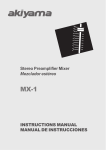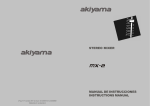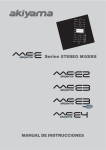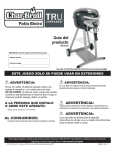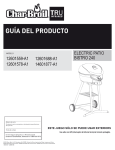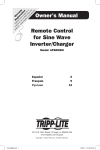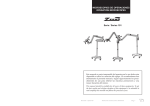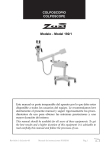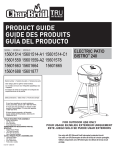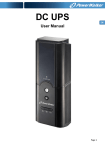Download instructions manual manual de instrucciones
Transcript
4 channel stereo mixer with DSP effects INSTRUCTIONS MANUAL MANUAL DE INSTRUCCIONES C/ Praga, nº 11. Pol. Cova Solera. 08191. Rubi (Barcelona). Tel: 00 34 935861730 Fax: 00 34 936996087. E-mail: [email protected] / www.akiyamadj.com CONNECTIONS / CONEXIONES WARNINGS / AVISOS XLR connector for Mic at front panel CAUTION Conector XLR para Micrófono en panel frontal RISK OF ELECTRIC SHOCK DO NOT OPEN Jack connector for MIC Conector Jack para Micrófono h h Channel 1 can act as DJ Mic channel or as normal POWER AMPLIFIER/ETAPA DE POTENCIA h h h h h h h h h Up to 7 line level devices can be connected Podemos conectar hasta 7 aparatos de nivel de señal de linea Up to 3 turntables can be connected Podemos conectar hasta 3 giradiscos Esta señal indica la presencia de componentes del equipo que precisan de mantenimiento. Para más información sobre éstos lea el manual. A continuación le consignamos las instrucciones del equipo. Gracias por haber elegido un productoAkiyama. h To secondary amplifier A amplificador secundario Esta señal indica la presencia de lugares donde habiendo un elevado voltaje no presentan aislamiento y por tanto constituye un claro riesgo de electrocución. h h h h stereo Line level channel. On front panel there is a switch to select mode between Mic and Line. We have two possible ways to connect Microphone, via canon connector in front panel or via Jack connector in back panel. El canal 1 puede funcionar como canal de micrófono o como canal estéreo (Línea). Mediante el conmutador adjunto al canal podemos escoger el modo de funcionamiento. Podemos conectar el micrófono o en el panel frontal con un conector canon o en el panel trasero con un conector Jack. The exclamation point within an equilateral triangle is intended to alert user to the presence of important operating and maintenance instructions in the literature accompanying the appliance. Estimado Cliente: channel 1 To Recorder system A sist. grabador This lightning flash arrowhead is intended to alert use the presence of uninsulated “dangerous voltage” within the product´s enclosure that may be of sufficient magnitude to constitute a risk of electric shock to humans. Before Use / Security Advice h Earth contact for Turntable Toma de tierra para giradiscos CAUTION, RISK OF ELECTRIC SHOCK, DO NOT OPEN. ATENTION: TO REDUCE RISK OF ELECTRIC SHOCK DO NOT OPERATE INSIDE THE EQUIPMENT. FOR MAINTENANCE CONTACTYOUR DEALER OR QUALIFIED PERSONNEL. ATENCION: PARAREDUCIR EL RIESGO DE ELECTROCUCION, NO MANIPULE EL INTERIOR DEL EQUIPO. PARA REALIZAR EL MANTENIMIENTO DEL EQUIPO PONGASE EN CONTACTO CON EL PERSONAL QUALIFICADO h h Read this manual completely before using the product. Keep this manual in your records for future reference. Follow all instructions printed in this manual, otherwise warranty may be void. To pull the AC cord out of the wall outlet, never pull the cable itself, but only theAC plug. Pull the AC plug out of the wall outlet before any kind of cleaning of this product. Use smooth and dry cloth only for cleaning. Check all connection cables before switching the unit again. Never use any accessories or modifications not authorised by the manufacturer of this unit. This can affect the security of the product and the manufacturer will not take any responsibility in this case. Avoid any use near open water or high humidity to prevent the risk of electric shock or fire. Take also care of not placing the unit near sources of heat (e.g. powerful amplifiers). Choose a location for operation where the unit is protected from vibration and where a fixed ground is provided. The manufacturer will not take any responsibility in case of damage caused by the product having fallen of the operation ground. Take care of enough distance between this product and sources of hum and noise like electric motors and transformers. Carry this product with great care. Punches, big forces and heavy vibration may damage this product mechanically. Take always care of sufficient air convection in this product´s enviroment to avoid overheating, specially when mounting in a rack or in a case. Before plugging the AC cord on the wall outlet check whether the AC mains voltage and frequency is the same as this product is specified for. Whenever your AC plug should not match the wall outlet contact your dealer immediately. Choose the position of theAC cord according to the lowest risk of damage by foot steps or by squeezing it. Take especial care of the AC cord outlet on the unit as well as theAC plug and wall outlet an the other end of the cable. Pull the AC plug out of the wall outlet during thunder-storm in order to avoid any damage on the unit due toAC voltage peaks. Check the total maximum power of the AC wall outlet if you connect several units to one wall outlet, and avoid to overload the wall outlet because this may bring fire. If fluids have spilled into the unit or small parts have intruded the unit, immediately switch off the unit and hand it over to servicing. Do not open the unit for service purpose, as there are no user serviceable parts inside. Consequently the manufacturer will not take any responsibility for damage or personal injury following unauthorised service by the user. In addition, warranty will be void in any case of unauthorised service by the user or other non authorised persons. In cause of not correct function of this unit or damaged AC cord or other damaged parts, pull immediately the AC plug out of the wall outlet and hand it over the authorised service for security check. To meet all aspects of functionality and security during maintenance work to be performed on this unit, all parts should be replaced by genuine spares. Consequently, take care of your dealer or maintenance company to be authorised by the manufacturer. Antes de utilizar el equipo lea detenidamente las siguientes instrucciones: h h h h h h h h h h h h h h h h h h h Lea detenidamente el manual antes de utilizar su equipo. Mantenga el manual a su disposición para su uso en el futuro. Siga las instrucciones consignadas en el manual, un uso indebido del equipo podría dejar sin efecto la garantía. Para desconectar la clavija de toma de corriente AC, nunca estire del cable. Hágalo estirando la clavija. Desconecte el equipo antes de realizar alguna operación de limpieza al aparato. Utilice un trapo suave y seco para limpiar. Asegúrese de que los cables están correctamente conectados antes de volver a poner en funcionamiento el equipo. Nunca utilice accesorios o realice modificaciones no autorizadas por el fabricante. Ello puede afectar a la integridad del equipo y el fabricante queda exonerado de responsabilidad alguna en este caso. No utilice el equipo cerca del agua o en lugares muy húmedos para evitar riesgos de descarga eléctrica o fuego. Además evite colocar el equipo cerca de fuentes de calor (Ej. amplificadores). Sitúe el equipo en lugares exentos de vibraciones y donde una correcta sujeción al piso sea posible. El fabricante queda libre de toda responsabilidad en caso de caída del aparato. Sitúe el equipo a suficiente distancia de fuentes de ruido eléctrico provocado por motores eléctricos o transformadores. Transporte el equipo con cuidado. Los golpes podrían dañarlo. Tenga siempre presente que colocar el aparato en un lugar sin ventilación puede producir un sobre calentamiento del mismo. Antes de conectar el equipo a la red asegúrese de que se trata del voltaje y frecuencia adecuado. En caso contrario absténgase de conectar el aparato y póngase en contacto con su distribuidor. Elija una posición para el cable de conexión a red de forma que esté guarecido de pisotones y otras agresiones. Especial atención a los extremos del cable de conexión, es decir las clavijas de conexión a red y a la toma del propio aparato Durante una tormenta desconecte el equipo de la red. Posibles descargas eléctricas dañarían el aparato. En caso de conectar varios equipos a la misma toma de la red verifique que se dispone de la suficiente potencia. En caso de que la potencia no fuera la suficiente se produciría una sobrecarga y se podría dañar los equipos En caso de que algún fluido o pequeñas partículas sólidas sean derramadas sobre el aparato y se introduzcan en éste, apáguelo y llévelo al servicio técnico para su verificación. No manipule el equipo con fines a su manutención pues éste no dispone de piezas que lo precisen. En caso de que se manipule el interior del equipo la empresa queda exonerada de cualquier responsabilidad para con el equipo y la persona que lo manipula.Además la garantía pierde su vigencia. En caso de que el aparato no funcione correctamente por cualquier razón imputable al equipo, desconéctelo de la red y llévelo a un distribuidor autorizado para su revisión. Durante cualquier manipulación del equipo, para mantener todas las cualidades del mismo tanto en prestaciones como en seguridad para el usuario es necesario utilizar sólo recambios originales. Asegúrese de que la empresa que realice el mantenimiento esté autorizada por el fabricante o distribuidor. Health advise Aviso que atañe a su salud This unit produces and absorbs electromagnetic radiation. The strength of radiation and the sensitivity for disturbing interference meet the CE requirements. A corresponding is printed on the backside of the unit. Any change or modification may affect the behaviour of the unit concerning electromagnetic radiation, with the CE requirements eventually not to be meet anymore. Este equipo produce y absorbe radiación electromagnética. La intensidad y la sensibilidad a distorsiones del exterior cumplen los criterios especificados por la C.E. En la parte posterior del equipo aparece un signo indicando la adecuación a las normas C.E. En caso de realizarse alguna manipulación no autorizada sobre el equipo podría alterarse las características del campo magnético producido por el equipo. En dicho caso el fabricante/distribuidor queda exento de toda responsabilidad. CD PLAYER/REPRODUCTOR DE CD 8 mcx TURNTABLE/GIRADISCOS mcx 1 FUNCTIONS Front Panel FUNCIONES 9 1 Panel trasero 1 3 english 8 2 11 1 4 5 10 2 3 4 11 12 21 22 5 23 10 6 8 9 7 24 6 25 26 27 13 7 28 17 14 18 29 15 30 19 7.- Salida Master Balanceada - Conector XLR3 o Canon. Este tipo de conexión es usada para conectar el mezclador a una etapa de potencia profesional. Es especialmente útil cuando el cable de conexión es largo, dado que en estas condiciones incorpora ruidos que el circuito de balanceo anula. 8.- Salida Booth L,R - Se trata de un segundo Master dedicado a la cabina del Disk Jockey (es necesario otro amplificador) 9.- REC (grabación) L,R - Se utiliza para grabar las sesiones. Es independiente del control Master, incluso con Master al mínimo seguimos registrando la sesión. 10.- Conexión a redAC - Conecte a la red de suministro eléctrico. Atención: Asegurese siempre de que la tensión y frecuencia de la red coinciden con los indicados en el mezclador. 11.- Conexión a tierra - Los giradiscos disponen de un cable auxiliar de masa o tierra. Conecte este cable a la toma de tierra del mezclador, de este modo anulamos los posibles ruidos de masa o tierra (hum). SEÑALES DE ENTRADA 1.- Entradas Phono L,R - Inserte aquí los conectores RCA de los giradiscos tipo (MM, moving magnet). 2.- Entradas de nivel de linea L,R -Inserte aquí los conectores RCA de cualquier fuente de señal de linea (CD Player, MD player, Cassette Player etc.) 3.- Igual al punto (2) 4.- Entrada auxiliar de Micrófono (Jack 6.3) - El micrófono dispone de dos entradas, una Canon en el panel frontal y una Jack 6.3 en el panel trasero. 5.- Entradas de nivel de linea L,R - Igual al punto (2) SEÑALES DE SALIDA 6.- Salida Master L,R (RCA) - Conecte al amplificador. Normalmente usamos esta salida para conectar a amplificadores domésticos o amplificadores que no necesitan cables largos. 16 20 Booth controls. Furthermore, the level of the channels can depend on the setting of the Crossfader if these channels are assigned to it by means of the Crossfader assign control. To be in-field replaceable, this part is front-detachable. For replacement, switch off the unit and unscrew the 2 outer screws of the crossfader and remove the part; detach the connector and replace the part. Plug in the connector and screw the new part to the main body again. 7.-Crossfader selector: By means of this control we can send the channel signal to: -A:Crossfader Left and Left bank of Kill effect -B: Crossfader Right and Right bank of Kill effect -Bypass: Send channel signal strait to Master Bus 8.-Microphone connector THE CHANNEL 1.-Input assign switches: These switches allow to choose which of the following backpanel inputs will be audible: Phono (turntable MM cartridge) or CD or Line (CD and Line inputs are same characteristics) 2.-Gain Control: Allows the adjustment of the channel input sensitivity regarding the different source levels. Each channel has an optical check up by means of the 10 LED bargraphs of the level meter. 3.-Channel EQ: Independent control is provided for the high (13KHz), the mid (1KHz) and the low (70Hz) frequency band. Please be aware, that any boosted frequency band will increase the total level and decrease the level headroom. 4.-Channel level meter: The meter display the channel level before channel fader. To set the channel at the right level, when in play back, set the Gain in a way that all green Leds light and the yellow and red only blink. 5.-Headphones assign switch (Cue): With these switches you can assign any of the input channels to be replayed on the headphones. Please note that you can only hear the required source if the input assign switch is switched to the respective position and the source is in play mode. 6.-Channel fader: By means of these controls, you determine the part of the overall level, that a specific channel contributes. Please be aware of the final output level to be adjusted by the Master and 2 MASTER SECTION (and Crossfader) Conectores RCA Jack 6.3 mono Entradas y salidas de Linea y Phono Micrófono panel trasero XLR3 o Canon Jack 6.3 stereo Salida Master Balanceada Auriculares 9.-Power switch: With the AC plug plugged into the wall outlet, the unit may be switched on by means of this switch; a second press of the switch will switch the unit off again. Once the mixer is switched on the FX Section displays will light up.Attention: Always take care of switching on your mixer first and your amplifier at last to avoid switching noise damaging your speakers; for switching off, switch off your amplifier first and your mixer at last. Shield:sleve Hot: tip Cold: ring mcx mcx 7 FUNCIONES FUNCTIONS 20.- Conector para auriculares: Jack 6.3 estereo. Conecte aqui sus auriculares 10.- Nivel de Señal de salida: Se dispone de dos picómetros. Miden el nivel de señal en un rango de -20 a +9 dB. Existen dos modos de monitorización: SECCIÓN DE EFECTOS. DSP 21.- Analizador de Beat (BPM) para señal Master: El sofisticado analizador de BPM ofrece una lectura del valor en el display. 22.- Display de parámetros (parámetro/bpm): El valor representado en el display dependerá del estado del selector de efectos de canal (27) y del canal seleccionado para envio a efectos (28). Al actuar sobre este control nos proporcionará el valor BPM del canal seleccionado. El display parpadeará en caso de no poder analizar el Beat. 23.- Beat (Effect Synchronous Display/Beat Display): La medida indicada dependerá de la posición del Selector de Efectos (27). 1) Si hemos seleccionado DELAY/ECHO/PAN/TRANS: el parámetro del efecto se representa en forma de Beat. Si el valor del parámetro del efecto es 1/2, 3/4, 1/1, 2/1 ó 4/1 se iluminará el LED correspondiente. Presionando el control Beat (24) cambiamos el valor del parámetro. En caso de que exista una disparidad en el número de Beats el LED correspondiente al valor más próximo parpadeará. 2) Si hemos seleccionado FILTER/FLANGER: el parámetro del efecto se representa en forma de Beat. Si el valor del parámetro del efecto es 1/2, 3/4, 1/1, 2/1 o 4/1 se iluminará el LED correspondiente. Presionando el control Beat (24) cambiamos el valor del parámetro. En caso de que exista una disparidad en el número de Beats el LED correspondiente al valor más próximo parpadeará. 3) Si hemos seleccionado PITCH: se indica el porcentaje de Ptich seleccionado. 24.- Selector de beat de efectos: Varia el valor del parámetro de efectos, display (25), ajustándolo a múltiplos del valor de BPM del canal seleccionado mediante el control (28). La naturaleza de el parámetro dependerá del efecto seleccionado mediante (27). 1) Si hemos seleccionado DELAY/ECHO/PAN/TRANS: el parámetro del efecto se representa en forma de Beat. Presionando el control Beat (24) podremos escoger entre los siguientes múltiplos del valor de BPM 1/2, 3/4, 1/1,2/1 o 4/1. 2) Si hemos seleccionado FILTER/FLANGER: el parámetro del efecto se representa en forma de Beat. Presionando el control Beat (24) podremos escoger entre los siguientes múltiplos del valor de BPM 1/2, 3/4, 1/1,2/1 o 4/1. 3) Si hemos seleccionado PITCH: se indica el porcentaje de Pitch seleccionado. Presionando el control Beat (24) podremos escoger entre los siguientes valores porcentuales de Pitch -100%, -50%, 0%, 50% y 100%. 25.- Control de parámetros: Es utilizado para ajustar el valor de los parámetros del efecto seleccionado. 26.- Control de cantidad de efecto: Nos permite graduar el porcentaje de señal aplicada a efectos versus señal original. 27.- Selector de efecto: Nos permite seleccionar el efecto a aplicar a la señal seleccionada. 28.- Selector de canal a efectos: Mediante este control escogemos el canal que sera afectado por la DSP de efectos. 29.- Preescucha de efectos: Nos permite realizar una pre/escucha de los efectos aplicados. 30.- Botón on/off de efectos: Activa el efecto escogido al canal seleccionado. I-Selector Stereo/Split en posición STEREO: escuchamos una mezcla estéreo de ambas señales. II-Selector Stereo/Split en posición SPLIT: en el auricular izquierdo escuchamos la señal entrante y en el auricular derecho la señal Master (ambas en mono). Girando el control graduamos el nivel de ambas señales. 16.- Control de volumen de auriculares. Le permite controlar el volumen en un auricular estéreo conectado al mezclador. Por favor, asegúrese de que la impedancia del auricular sea como mínimo de 32 Ohmios. Además, esté prevenido contra auriculares de elevada impedancia que reducirán el nivel máximo de salida en auricular. Se recomienda escoger un auricular con una impedancia no superior a 200 Ohmios. Atención, se recomienda mantener el volumen al mínimo antes de comenzar la reproducción. 17.- Boost: Incrementa en 6 dB el nivel de las frecuencias bajas de la señal (100Hz). Utilízalo en sincronía con el Beat. 18.- Crossfader: Dada la condición de los Fader de los canales que estén dirigidos al Crossfader estén “abiertos”, se podrá combinar la señal de éstos (acción de Crossfader o fundido). Para mayor operatividad y agilidad del equipo, el componente mecánico donde se localiza la función de Crossfader es reemplazable. Para reemplazar el Crossfader desaloje los tornillos exteriores y retire la pieza; desconecte el conector y cambie la pieza. De la nueva pieza conecte el conector y atornille la nueva pieza al equipo. 19.- Reverse: Invierte las entradas izquierda y derecha a Crossfader. Estando en modo Reverse un Led se iluminará. 6 mcx DSPEFFECTS SECTION 21.- Master Automatic bpm (beat per minute) counter display - This sophisticated counter automatically calculates the BPM of the signal at Master. 22.-Automatic (parameter/BPM Counter) info display - This sophisticated counter automatically calculates the BPM of any audio source selected by means of the control Source switch (28). Moreover, the display will differ with the setting of the effect channel selector switch (27). The BPM for the source selected with the effect channel selector knob (27) will be displayed. Display will flash while BPM is being measured or cannot be measured. 23.- Beat (Effect Synchronous Display/Beat Display) - The display will differ with the setting of the effect selector switch (27). 1. If DELAY, ECHO, PAN or TRANS has been selected, parameter for source BPM will be displayed in terms of a beat. It will light if the beat is from 1/2 to 4/1. Pressing the effect beat sync. button (24) will change beats clearing the display entirely. If there is a disparity between the number of beats, the closest number will be displayed blinking. 2. If FILTER, FLANGER has been selected, parameter for source BPM will be displayed in terms of a beat. Pressing the effect beat sync. button (24) will change the beat clearing the display entirely. If there is a disparity between the number of beats, the closest number will be displayed blinking. 3. If PITCH has been selected, the extent of pitch adjustment will be display. 24.- Effect beat sync. - The value for effect parameter (25) will change in keeping with the BPM for source selected with the effect source selector switch (28). The set value will change with the effect selector switch (27) setting. 1. If DELAY, ECHO, PAN or TRANS has been selected, parameter for source BPM will be set in terms of a beat (1/2 to 4/1). 2. IF FILTER, FLANGER has been selected, parameter for source BPM will be set in terms of a number of beats (1/2 to 4/1). 3. IF DELAY or ECHO has been selected, the number of beats for parameter cannot be set in excess of 2000 ms. 4. IF PITCH has been selected, settings of -100%, -50%, 0%, 50% and 100% will be possible. 25.- Parameter knob - Used to adjust the value of the parameters of the built-in effector. 26.- Effects Depth Control - Used to adjust the amount of effected music versus de amount of uneffected music. 27.- Effects selector switch - Used to select the effect to add to the music. 28.- Source Channel Selector switch - Used to select the source to be effected. 29.- Effects Cue - With these switch you replay on the headphones the effected music. 30.- Effect on/off button - Engages the effect selected to the selected source. mcx english I-Selector Stereo/Split en posición STEREO: mide el nivel de la señal MASTER. Cada Picómetro mide la señal de un canal (izquierdo y derecho respectivamente). Nos permite controlar la señal de salida de modo que no exista distorsión durante el proceso de mezcla. II-Selector Stereo/Split en posición SPLIT: El picómetro de la izquierda medirá el nivel de la señal de la fuente asignada a CUE y el picómetro de la derecha medirá el nivel de la señal del BUS MASTER en modo Mono. De este modo podremos comparar ambas señales. 11.- Control de nivel Booth: Controla independientemente de Master un amplificador externo. Advierta que la señal no se muestra en el medidor de nivel de señal de salida; consecuentemente, sea prudente y no sobrecargue su amplificador. 12.- Control de nivel Master & Balance: Controla independientemente del Booth un amplificador externo (el principal). Esta señal se muestra en el medidor de nivel de señal de salida. Mediante el control Balance Master podemos enviar la señal al canal izquierdo o derecho de las dos pistas estéreo. 13.- Selector Mono/Stereo: Podemos transformar la señal de salida, normalmente estéreo, en mono. 14.- Conmutador Stereo/Split para auriculares: En posición estéreo le permitirá escuchar la señal preseleccionada mediante CUE en estéreo. En posición Split escuchará en un auricular la señal preseleccionada mediante CUE y en el otro la señal Master (ambas en mono). 15.- Control panorámico de CUE: Mediante esta función podrá escuchar una mezcla entre las señales entrantes (señal preseleccionada CUE) y la señal de salida Master (pre pot). 10.-Level meter: The level meter shows the stereo output level of Master output when CUE selector in Stereo mode. When CUE selector in Split mode the left bargraph will show CUE level and the right bargraph will depict Master level. 11.-Booth level control: Controls independently from Master an external amplifier. Please note that the level of this output will not in any case be displayed on the level meter; consequently, please check carefully for your amplifier not being overloaded. 12.-Master level control & Balance: Controls independently from Booth an external amplifier (main amplifier). The signal's stereo balance can be controlled by means of control Balance Master. This signal is displayed on the level meter. 13.-Mono/Stereo Selector: We can transform output signal, normally stereo, in mono. 14.-Stereo/split-switch for headphones: Position "stereo" will make you hear the preselected signal by means of CUE controls in stereo, while position "split" will make you hear the CUE preselected signal on one earcup and the Master output signal on the other earcup. 15.-Cue Pan: By means of this function, you can preview your forthcoming mix by crossfading between the preselected headphones signal on the left side of the control and the Master output signal (pre pot) on the right side of the control. 16.-Headphones level control: With a stereo headphone connected, you may control the headphones volume. Please check your headphones impedance for a minimum of 32 Ohms and be aware of high-impedance headphones reducing the maximum output power of this output, so that you should choose a headphone with less than 200 Ohms of impedance. 17.-Boost: Increases 6 dB the level of low level frequencies (100Hz). Use it to enhance the Beat. 18.-Crossfader: Under the precondition of opened channel faders of those channels being routed to the crossfader, you can crossfade between these two input channels. To be in-field replaceable, this part is front-detachable. For replacement, switch off the unit and unscrew the 2 outer screws of the crossfader and remove the part; detach the connector and replace the part. Plug in the connector and screw the new part to the main body again. 19.-Reverse: Reverses the inputs right and left to the crossfader. When in reverse mode a Led will light. 20.-Headphones connector: Jack 6.3 stereo. Connect here the headphones. 3 FUNCTIONS FUNCIONES Panel frontal Rear Panel 9 1 1 3 2 11 1 4 5 8 10 english 2 3 4 11 12 21 22 5 10 6 8 9 23 7 24 6 professional use. Specially when cable lines are long and therefore can caught unwanted noise. 8.- Booth output L,R - This is a second Master output normally used for monitoring at the DJ cabin (when avaialble). 9.- REC L,R - The record output is not affected by the Master volume control. It can be used to record even while the master volume is off. 10.- AC Input - Input connection for the inboard power supply. Connect it to the wall outlet socket. Always assure that the tension and frequency of the outlet matched the specified at the mixer. 11.- Ground connector - Connects to the turntable ground connector to eliminate electrical hum. Ground connectors are usually supplied with turntables. INPUTS 1.- Phono inputs L,R - Insert here connectors from turntables (MM) type 2.- Cd level inputs L,R - Insert here connectors from any line level signal device. That is CD Player, MD player, Cassette Player etc. 3.- Line level inputs L,R - Same as point (2) 4.- Mic input (Jack 6.3) - Microphone has the input connector duplicated. You have one at the front panel and another at rear panel. That is a Jack 6.3. 5.- Line level inputs L,R - Same as point (2) OUTPUTS 6.- Master output L,R (RCA) - Connect to the amplfier system. Normally RCA output are used at domestic setups or cable lines are short. 7.- Balanced Master output - Balanced XLR3 or Cannon connectors are typically used to connect to the amplfier system for 25 26 27 13 7 28 17 14 18 29 15 30 19 16 20 6.- Fader de canal: Mediante estos controles, usted determina la parte del nivel global al que un canal específico contribuye. Por favor advierta que el nivel final de salida debe ser ajustado mediante el Master y el Booth. Además el nivel de los canales puede depender del Crossfader en caso de que el canal sea direccionado al Crossfader por medio del control de asignación a Crossfader (a/b/bypass). 7.-Selector de Crossfader & Kill: Nos permite enviar la señal del canal a: -A: Crossfader Izquierdo y módulo izquierdo de Kill -B: Crossfader Derecho y módulo Derecho de Kill -Bypass: Envía la señal del canal directamente al Master Bus 8.- Conector XLR (Canon) para micrófono EL CANAL Connectors RCA Jack 6.3 mono Line and Phono inputs Several outputs Rear panel Microphon XLR3 o Canon Jack 6.3 stereo Master Balanced output Headphones Shield:sleve Hot: tip Cold: ring 4 mcx 1.- Conmutadores de asignación de entradas: Mediante la palanca de cada canal decidimos que fuente reproductora está activa de las tres posibles conectadas a cada canal. Se dispone de tres posibles selecciones: Phono (giradiscos con cápsula MM) CD, Linea (CD y Línea son el mismo tipo de entrada) 2.- Control de ganancia: Permite el ajuste de la sensibilidad del canal de entrada en función de las distintas fuentes. Para cada canal es posible realizar un ajuste óptico mediante la barra de LED o picómetro . 3.-Ecualizador de Canal : Se dispone de un control independiente para frecuencias altas (13KHz), medidas (1KHz) y bajas (70Hz). Por favor advierta que cualquier banda de frecuencia sobre elevada incrementará el nivel total y hará decrecer el rango dinámico del equipo. Además, puede elevar el nivel global de la señal hasta llegar a la saturación. 4.- Medidor de nivel de canal: Nos indica el nivel de la señal en el canal justo antes de la atenuación del fader. Para regular la sensibilidad de entrada actúe sobre el control Gain de modo que las luces verdes del medidor estén encendidas y las luces naranja y rojas sólo se enciendan ocasionalmente. 5.- Conmutador de asignación de auriculares (CUE): Mediante estos conmutadores usted puede asignar cualquiera de los canales de entrada para ser reproducidos a través de los auriculares. Por favor advierta que sólo podrá escuchar la fuente deseada si el conmutador de asignación de entradas está conectado en su posición correspondiente y el equipo fuente está reproduciendo. Atención, se recomienda mantener el volumen al mínimo antes de comenzar la reproducción. SECCIÓN MASTER (y Crossfader) 9.- Interruptor puesta en marcha: Conectar el dispositivo de conexión a red AC a la toma de la pared. Accionando el conmutador power switch el aparato será puesto en marcha. Mediante una segunda acción sobre el conmutador el aparato se apagará. Al presionar el botón ON los displays se iluminarán. Atención: Tenga siempre la precaución de enchufar primero el mezclador y a continuación el amplificador para evitar que el ruido de conexión dañe sus altavoces; para apagar el equipo, apague primero el amplificador y a continuación el mezclador. mcx 5 FUNCTIONS FUNCIONES Panel frontal Rear Panel 9 1 1 3 2 11 1 4 5 8 10 english 2 3 4 11 12 21 22 5 10 6 8 9 23 7 24 6 professional use. Specially when cable lines are long and therefore can caught unwanted noise. 8.- Booth output L,R - This is a second Master output normally used for monitoring at the DJ cabin (when avaialble). 9.- REC L,R - The record output is not affected by the Master volume control. It can be used to record even while the master volume is off. 10.- AC Input - Input connection for the inboard power supply. Connect it to the wall outlet socket. Always assure that the tension and frequency of the outlet matched the specified at the mixer. 11.- Ground connector - Connects to the turntable ground connector to eliminate electrical hum. Ground connectors are usually supplied with turntables. INPUTS 1.- Phono inputs L,R - Insert here connectors from turntables (MM) type 2.- Cd level inputs L,R - Insert here connectors from any line level signal device. That is CD Player, MD player, Cassette Player etc. 3.- Line level inputs L,R - Same as point (2) 4.- Mic input (Jack 6.3) - Microphone has the input connector duplicated. You have one at the front panel and another at rear panel. That is a Jack 6.3. 5.- Line level inputs L,R - Same as point (2) OUTPUTS 6.- Master output L,R (RCA) - Connect to the amplfier system. Normally RCA output are used at domestic setups or cable lines are short. 7.- Balanced Master output - Balanced XLR3 or Cannon connectors are typically used to connect to the amplfier system for 25 26 27 13 7 28 17 14 18 29 15 30 19 16 20 6.- Fader de canal: Mediante estos controles, usted determina la parte del nivel global al que un canal específico contribuye. Por favor advierta que el nivel final de salida debe ser ajustado mediante el Master y el Booth. Además el nivel de los canales puede depender del Crossfader en caso de que el canal sea direccionado al Crossfader por medio del control de asignación a Crossfader (a/b/bypass). 7.-Selector de Crossfader & Kill: Nos permite enviar la señal del canal a: -A: Crossfader Izquierdo y módulo izquierdo de Kill -B: Crossfader Derecho y módulo Derecho de Kill -Bypass: Envía la señal del canal directamente al Master Bus 8.- Conector XLR (Canon) para micrófono EL CANAL Connectors RCA Jack 6.3 mono Line and Phono inputs Several outputs Rear panel Microphon XLR3 o Canon Jack 6.3 stereo Master Balanced output Headphones Shield:sleve Hot: tip Cold: ring 4 mcx 1.- Conmutadores de asignación de entradas: Mediante la palanca de cada canal decidimos que fuente reproductora está activa de las tres posibles conectadas a cada canal. Se dispone de tres posibles selecciones: Phono (giradiscos con cápsula MM) CD, Linea (CD y Línea son el mismo tipo de entrada) 2.- Control de ganancia: Permite el ajuste de la sensibilidad del canal de entrada en función de las distintas fuentes. Para cada canal es posible realizar un ajuste óptico mediante la barra de LED o picómetro . 3.-Ecualizador de Canal : Se dispone de un control independiente para frecuencias altas (13KHz), medidas (1KHz) y bajas (70Hz). Por favor advierta que cualquier banda de frecuencia sobre elevada incrementará el nivel total y hará decrecer el rango dinámico del equipo. Además, puede elevar el nivel global de la señal hasta llegar a la saturación. 4.- Medidor de nivel de canal: Nos indica el nivel de la señal en el canal justo antes de la atenuación del fader. Para regular la sensibilidad de entrada actúe sobre el control Gain de modo que las luces verdes del medidor estén encendidas y las luces naranja y rojas sólo se enciendan ocasionalmente. 5.- Conmutador de asignación de auriculares (CUE): Mediante estos conmutadores usted puede asignar cualquiera de los canales de entrada para ser reproducidos a través de los auriculares. Por favor advierta que sólo podrá escuchar la fuente deseada si el conmutador de asignación de entradas está conectado en su posición correspondiente y el equipo fuente está reproduciendo. Atención, se recomienda mantener el volumen al mínimo antes de comenzar la reproducción. SECCIÓN MASTER (y Crossfader) 9.- Interruptor puesta en marcha: Conectar el dispositivo de conexión a red AC a la toma de la pared. Accionando el conmutador power switch el aparato será puesto en marcha. Mediante una segunda acción sobre el conmutador el aparato se apagará. Al presionar el botón ON los displays se iluminarán. Atención: Tenga siempre la precaución de enchufar primero el mezclador y a continuación el amplificador para evitar que el ruido de conexión dañe sus altavoces; para apagar el equipo, apague primero el amplificador y a continuación el mezclador. mcx 5 FUNCIONES FUNCTIONS 20.- Conector para auriculares: Jack 6.3 estereo. Conecte aqui sus auriculares 10.- Nivel de Señal de salida: Se dispone de dos picómetros. Miden el nivel de señal en un rango de -20 a +9 dB. Existen dos modos de monitorización: SECCIÓN DE EFECTOS. DSP 21.- Analizador de Beat (BPM) para señal Master: El sofisticado analizador de BPM ofrece una lectura del valor en el display. 22.- Display de parámetros (parámetro/bpm): El valor representado en el display dependerá del estado del selector de efectos de canal (27) y del canal seleccionado para envio a efectos (28). Al actuar sobre este control nos proporcionará el valor BPM del canal seleccionado. El display parpadeará en caso de no poder analizar el Beat. 23.- Beat (Effect Synchronous Display/Beat Display): La medida indicada dependerá de la posición del Selector de Efectos (27). 1) Si hemos seleccionado DELAY/ECHO/PAN/TRANS: el parámetro del efecto se representa en forma de Beat. Si el valor del parámetro del efecto es 1/2, 3/4, 1/1, 2/1 ó 4/1 se iluminará el LED correspondiente. Presionando el control Beat (24) cambiamos el valor del parámetro. En caso de que exista una disparidad en el número de Beats el LED correspondiente al valor más próximo parpadeará. 2) Si hemos seleccionado FILTER/FLANGER: el parámetro del efecto se representa en forma de Beat. Si el valor del parámetro del efecto es 1/2, 3/4, 1/1, 2/1 o 4/1 se iluminará el LED correspondiente. Presionando el control Beat (24) cambiamos el valor del parámetro. En caso de que exista una disparidad en el número de Beats el LED correspondiente al valor más próximo parpadeará. 3) Si hemos seleccionado PITCH: se indica el porcentaje de Ptich seleccionado. 24.- Selector de beat de efectos: Varia el valor del parámetro de efectos, display (25), ajustándolo a múltiplos del valor de BPM del canal seleccionado mediante el control (28). La naturaleza de el parámetro dependerá del efecto seleccionado mediante (27). 1) Si hemos seleccionado DELAY/ECHO/PAN/TRANS: el parámetro del efecto se representa en forma de Beat. Presionando el control Beat (24) podremos escoger entre los siguientes múltiplos del valor de BPM 1/2, 3/4, 1/1,2/1 o 4/1. 2) Si hemos seleccionado FILTER/FLANGER: el parámetro del efecto se representa en forma de Beat. Presionando el control Beat (24) podremos escoger entre los siguientes múltiplos del valor de BPM 1/2, 3/4, 1/1,2/1 o 4/1. 3) Si hemos seleccionado PITCH: se indica el porcentaje de Pitch seleccionado. Presionando el control Beat (24) podremos escoger entre los siguientes valores porcentuales de Pitch -100%, -50%, 0%, 50% y 100%. 25.- Control de parámetros: Es utilizado para ajustar el valor de los parámetros del efecto seleccionado. 26.- Control de cantidad de efecto: Nos permite graduar el porcentaje de señal aplicada a efectos versus señal original. 27.- Selector de efecto: Nos permite seleccionar el efecto a aplicar a la señal seleccionada. 28.- Selector de canal a efectos: Mediante este control escogemos el canal que sera afectado por la DSP de efectos. 29.- Preescucha de efectos: Nos permite realizar una pre/escucha de los efectos aplicados. 30.- Botón on/off de efectos: Activa el efecto escogido al canal seleccionado. I-Selector Stereo/Split en posición STEREO: escuchamos una mezcla estéreo de ambas señales. II-Selector Stereo/Split en posición SPLIT: en el auricular izquierdo escuchamos la señal entrante y en el auricular derecho la señal Master (ambas en mono). Girando el control graduamos el nivel de ambas señales. 16.- Control de volumen de auriculares. Le permite controlar el volumen en un auricular estéreo conectado al mezclador. Por favor, asegúrese de que la impedancia del auricular sea como mínimo de 32 Ohmios. Además, esté prevenido contra auriculares de elevada impedancia que reducirán el nivel máximo de salida en auricular. Se recomienda escoger un auricular con una impedancia no superior a 200 Ohmios. Atención, se recomienda mantener el volumen al mínimo antes de comenzar la reproducción. 17.- Boost: Incrementa en 6 dB el nivel de las frecuencias bajas de la señal (100Hz). Utilízalo en sincronía con el Beat. 18.- Crossfader: Dada la condición de los Fader de los canales que estén dirigidos al Crossfader estén “abiertos”, se podrá combinar la señal de éstos (acción de Crossfader o fundido). Para mayor operatividad y agilidad del equipo, el componente mecánico donde se localiza la función de Crossfader es reemplazable. Para reemplazar el Crossfader desaloje los tornillos exteriores y retire la pieza; desconecte el conector y cambie la pieza. De la nueva pieza conecte el conector y atornille la nueva pieza al equipo. 19.- Reverse: Invierte las entradas izquierda y derecha a Crossfader. Estando en modo Reverse un Led se iluminará. 6 mcx DSPEFFECTS SECTION 21.- Master Automatic bpm (beat per minute) counter display - This sophisticated counter automatically calculates the BPM of the signal at Master. 22.-Automatic (parameter/BPM Counter) info display - This sophisticated counter automatically calculates the BPM of any audio source selected by means of the control Source switch (28). Moreover, the display will differ with the setting of the effect channel selector switch (27). The BPM for the source selected with the effect channel selector knob (27) will be displayed. Display will flash while BPM is being measured or cannot be measured. 23.- Beat (Effect Synchronous Display/Beat Display) - The display will differ with the setting of the effect selector switch (27). 1. If DELAY, ECHO, PAN or TRANS has been selected, parameter for source BPM will be displayed in terms of a beat. It will light if the beat is from 1/2 to 4/1. Pressing the effect beat sync. button (24) will change beats clearing the display entirely. If there is a disparity between the number of beats, the closest number will be displayed blinking. 2. If FILTER, FLANGER has been selected, parameter for source BPM will be displayed in terms of a beat. Pressing the effect beat sync. button (24) will change the beat clearing the display entirely. If there is a disparity between the number of beats, the closest number will be displayed blinking. 3. If PITCH has been selected, the extent of pitch adjustment will be display. 24.- Effect beat sync. - The value for effect parameter (25) will change in keeping with the BPM for source selected with the effect source selector switch (28). The set value will change with the effect selector switch (27) setting. 1. If DELAY, ECHO, PAN or TRANS has been selected, parameter for source BPM will be set in terms of a beat (1/2 to 4/1). 2. IF FILTER, FLANGER has been selected, parameter for source BPM will be set in terms of a number of beats (1/2 to 4/1). 3. IF DELAY or ECHO has been selected, the number of beats for parameter cannot be set in excess of 2000 ms. 4. IF PITCH has been selected, settings of -100%, -50%, 0%, 50% and 100% will be possible. 25.- Parameter knob - Used to adjust the value of the parameters of the built-in effector. 26.- Effects Depth Control - Used to adjust the amount of effected music versus de amount of uneffected music. 27.- Effects selector switch - Used to select the effect to add to the music. 28.- Source Channel Selector switch - Used to select the source to be effected. 29.- Effects Cue - With these switch you replay on the headphones the effected music. 30.- Effect on/off button - Engages the effect selected to the selected source. mcx english I-Selector Stereo/Split en posición STEREO: mide el nivel de la señal MASTER. Cada Picómetro mide la señal de un canal (izquierdo y derecho respectivamente). Nos permite controlar la señal de salida de modo que no exista distorsión durante el proceso de mezcla. II-Selector Stereo/Split en posición SPLIT: El picómetro de la izquierda medirá el nivel de la señal de la fuente asignada a CUE y el picómetro de la derecha medirá el nivel de la señal del BUS MASTER en modo Mono. De este modo podremos comparar ambas señales. 11.- Control de nivel Booth: Controla independientemente de Master un amplificador externo. Advierta que la señal no se muestra en el medidor de nivel de señal de salida; consecuentemente, sea prudente y no sobrecargue su amplificador. 12.- Control de nivel Master & Balance: Controla independientemente del Booth un amplificador externo (el principal). Esta señal se muestra en el medidor de nivel de señal de salida. Mediante el control Balance Master podemos enviar la señal al canal izquierdo o derecho de las dos pistas estéreo. 13.- Selector Mono/Stereo: Podemos transformar la señal de salida, normalmente estéreo, en mono. 14.- Conmutador Stereo/Split para auriculares: En posición estéreo le permitirá escuchar la señal preseleccionada mediante CUE en estéreo. En posición Split escuchará en un auricular la señal preseleccionada mediante CUE y en el otro la señal Master (ambas en mono). 15.- Control panorámico de CUE: Mediante esta función podrá escuchar una mezcla entre las señales entrantes (señal preseleccionada CUE) y la señal de salida Master (pre pot). 10.-Level meter: The level meter shows the stereo output level of Master output when CUE selector in Stereo mode. When CUE selector in Split mode the left bargraph will show CUE level and the right bargraph will depict Master level. 11.-Booth level control: Controls independently from Master an external amplifier. Please note that the level of this output will not in any case be displayed on the level meter; consequently, please check carefully for your amplifier not being overloaded. 12.-Master level control & Balance: Controls independently from Booth an external amplifier (main amplifier). The signal's stereo balance can be controlled by means of control Balance Master. This signal is displayed on the level meter. 13.-Mono/Stereo Selector: We can transform output signal, normally stereo, in mono. 14.-Stereo/split-switch for headphones: Position "stereo" will make you hear the preselected signal by means of CUE controls in stereo, while position "split" will make you hear the CUE preselected signal on one earcup and the Master output signal on the other earcup. 15.-Cue Pan: By means of this function, you can preview your forthcoming mix by crossfading between the preselected headphones signal on the left side of the control and the Master output signal (pre pot) on the right side of the control. 16.-Headphones level control: With a stereo headphone connected, you may control the headphones volume. Please check your headphones impedance for a minimum of 32 Ohms and be aware of high-impedance headphones reducing the maximum output power of this output, so that you should choose a headphone with less than 200 Ohms of impedance. 17.-Boost: Increases 6 dB the level of low level frequencies (100Hz). Use it to enhance the Beat. 18.-Crossfader: Under the precondition of opened channel faders of those channels being routed to the crossfader, you can crossfade between these two input channels. To be in-field replaceable, this part is front-detachable. For replacement, switch off the unit and unscrew the 2 outer screws of the crossfader and remove the part; detach the connector and replace the part. Plug in the connector and screw the new part to the main body again. 19.-Reverse: Reverses the inputs right and left to the crossfader. When in reverse mode a Led will light. 20.-Headphones connector: Jack 6.3 stereo. Connect here the headphones. 3 FUNCTIONS Front Panel FUNCIONES 9 1 Panel trasero 1 3 english 8 2 11 1 4 5 10 2 3 4 11 12 21 22 5 23 10 6 8 9 7 24 6 25 26 27 13 7 28 17 14 18 29 15 30 19 7.- Salida Master Balanceada - Conector XLR3 o Canon. Este tipo de conexión es usada para conectar el mezclador a una etapa de potencia profesional. Es especialmente útil cuando el cable de conexión es largo, dado que en estas condiciones incorpora ruidos que el circuito de balanceo anula. 8.- Salida Booth L,R - Se trata de un segundo Master dedicado a la cabina del Disk Jockey (es necesario otro amplificador) 9.- REC (grabación) L,R - Se utiliza para grabar las sesiones. Es independiente del control Master, incluso con Master al mínimo seguimos registrando la sesión. 10.- Conexión a redAC - Conecte a la red de suministro eléctrico. Atención: Asegurese siempre de que la tensión y frecuencia de la red coinciden con los indicados en el mezclador. 11.- Conexión a tierra - Los giradiscos disponen de un cable auxiliar de masa o tierra. Conecte este cable a la toma de tierra del mezclador, de este modo anulamos los posibles ruidos de masa o tierra (hum). SEÑALES DE ENTRADA 1.- Entradas Phono L,R - Inserte aquí los conectores RCA de los giradiscos tipo (MM, moving magnet). 2.- Entradas de nivel de linea L,R -Inserte aquí los conectores RCA de cualquier fuente de señal de linea (CD Player, MD player, Cassette Player etc.) 3.- Igual al punto (2) 4.- Entrada auxiliar de Micrófono (Jack 6.3) - El micrófono dispone de dos entradas, una Canon en el panel frontal y una Jack 6.3 en el panel trasero. 5.- Entradas de nivel de linea L,R - Igual al punto (2) SEÑALES DE SALIDA 6.- Salida Master L,R (RCA) - Conecte al amplificador. Normalmente usamos esta salida para conectar a amplificadores domésticos o amplificadores que no necesitan cables largos. 16 20 Booth controls. Furthermore, the level of the channels can depend on the setting of the Crossfader if these channels are assigned to it by means of the Crossfader assign control. To be in-field replaceable, this part is front-detachable. For replacement, switch off the unit and unscrew the 2 outer screws of the crossfader and remove the part; detach the connector and replace the part. Plug in the connector and screw the new part to the main body again. 7.-Crossfader selector: By means of this control we can send the channel signal to: -A:Crossfader Left and Left bank of Kill effect -B: Crossfader Right and Right bank of Kill effect -Bypass: Send channel signal strait to Master Bus 8.-Microphone connector THE CHANNEL 1.-Input assign switches: These switches allow to choose which of the following backpanel inputs will be audible: Phono (turntable MM cartridge) or CD or Line (CD and Line inputs are same characteristics) 2.-Gain Control: Allows the adjustment of the channel input sensitivity regarding the different source levels. Each channel has an optical check up by means of the 10 LED bargraphs of the level meter. 3.-Channel EQ: Independent control is provided for the high (13KHz), the mid (1KHz) and the low (70Hz) frequency band. Please be aware, that any boosted frequency band will increase the total level and decrease the level headroom. 4.-Channel level meter: The meter display the channel level before channel fader. To set the channel at the right level, when in play back, set the Gain in a way that all green Leds light and the yellow and red only blink. 5.-Headphones assign switch (Cue): With these switches you can assign any of the input channels to be replayed on the headphones. Please note that you can only hear the required source if the input assign switch is switched to the respective position and the source is in play mode. 6.-Channel fader: By means of these controls, you determine the part of the overall level, that a specific channel contributes. Please be aware of the final output level to be adjusted by the Master and 2 MASTER SECTION (and Crossfader) Conectores RCA Jack 6.3 mono Entradas y salidas de Linea y Phono Micrófono panel trasero XLR3 o Canon Jack 6.3 stereo Salida Master Balanceada Auriculares 9.-Power switch: With the AC plug plugged into the wall outlet, the unit may be switched on by means of this switch; a second press of the switch will switch the unit off again. Once the mixer is switched on the FX Section displays will light up.Attention: Always take care of switching on your mixer first and your amplifier at last to avoid switching noise damaging your speakers; for switching off, switch off your amplifier first and your mixer at last. Shield:sleve Hot: tip Cold: ring mcx mcx 7 CONNECTIONS / CONEXIONES WARNINGS / AVISOS XLR connector for Mic at front panel CAUTION Conector XLR para Micrófono en panel frontal RISK OF ELECTRIC SHOCK DO NOT OPEN Jack connector for MIC Conector Jack para Micrófono h h Channel 1 can act as DJ Mic channel or as normal POWER AMPLIFIER/ETAPA DE POTENCIA h h h h h h h h h Up to 7 line level devices can be connected Podemos conectar hasta 7 aparatos de nivel de señal de linea Up to 3 turntables can be connected Podemos conectar hasta 3 giradiscos Esta señal indica la presencia de componentes del equipo que precisan de mantenimiento. Para más información sobre éstos lea el manual. A continuación le consignamos las instrucciones del equipo. Gracias por haber elegido un productoAkiyama. h To secondary amplifier A amplificador secundario Esta señal indica la presencia de lugares donde habiendo un elevado voltaje no presentan aislamiento y por tanto constituye un claro riesgo de electrocución. h h h h stereo Line level channel. On front panel there is a switch to select mode between Mic and Line. We have two possible ways to connect Microphone, via canon connector in front panel or via Jack connector in back panel. El canal 1 puede funcionar como canal de micrófono o como canal estéreo (Línea). Mediante el conmutador adjunto al canal podemos escoger el modo de funcionamiento. Podemos conectar el micrófono o en el panel frontal con un conector canon o en el panel trasero con un conector Jack. The exclamation point within an equilateral triangle is intended to alert user to the presence of important operating and maintenance instructions in the literature accompanying the appliance. Estimado Cliente: channel 1 To Recorder system A sist. grabador This lightning flash arrowhead is intended to alert use the presence of uninsulated “dangerous voltage” within the product´s enclosure that may be of sufficient magnitude to constitute a risk of electric shock to humans. Before Use / Security Advice h Earth contact for Turntable Toma de tierra para giradiscos CAUTION, RISK OF ELECTRIC SHOCK, DO NOT OPEN. ATENTION: TO REDUCE RISK OF ELECTRIC SHOCK DO NOT OPERATE INSIDE THE EQUIPMENT. FOR MAINTENANCE CONTACTYOUR DEALER OR QUALIFIED PERSONNEL. ATENCION: PARAREDUCIR EL RIESGO DE ELECTROCUCION, NO MANIPULE EL INTERIOR DEL EQUIPO. PARA REALIZAR EL MANTENIMIENTO DEL EQUIPO PONGASE EN CONTACTO CON EL PERSONAL QUALIFICADO h h Read this manual completely before using the product. Keep this manual in your records for future reference. Follow all instructions printed in this manual, otherwise warranty may be void. To pull the AC cord out of the wall outlet, never pull the cable itself, but only theAC plug. Pull the AC plug out of the wall outlet before any kind of cleaning of this product. Use smooth and dry cloth only for cleaning. Check all connection cables before switching the unit again. Never use any accessories or modifications not authorised by the manufacturer of this unit. This can affect the security of the product and the manufacturer will not take any responsibility in this case. Avoid any use near open water or high humidity to prevent the risk of electric shock or fire. Take also care of not placing the unit near sources of heat (e.g. powerful amplifiers). Choose a location for operation where the unit is protected from vibration and where a fixed ground is provided. The manufacturer will not take any responsibility in case of damage caused by the product having fallen of the operation ground. Take care of enough distance between this product and sources of hum and noise like electric motors and transformers. Carry this product with great care. Punches, big forces and heavy vibration may damage this product mechanically. Take always care of sufficient air convection in this product´s enviroment to avoid overheating, specially when mounting in a rack or in a case. Before plugging the AC cord on the wall outlet check whether the AC mains voltage and frequency is the same as this product is specified for. Whenever your AC plug should not match the wall outlet contact your dealer immediately. Choose the position of theAC cord according to the lowest risk of damage by foot steps or by squeezing it. Take especial care of the AC cord outlet on the unit as well as theAC plug and wall outlet an the other end of the cable. Pull the AC plug out of the wall outlet during thunder-storm in order to avoid any damage on the unit due toAC voltage peaks. Check the total maximum power of the AC wall outlet if you connect several units to one wall outlet, and avoid to overload the wall outlet because this may bring fire. If fluids have spilled into the unit or small parts have intruded the unit, immediately switch off the unit and hand it over to servicing. Do not open the unit for service purpose, as there are no user serviceable parts inside. Consequently the manufacturer will not take any responsibility for damage or personal injury following unauthorised service by the user. In addition, warranty will be void in any case of unauthorised service by the user or other non authorised persons. In cause of not correct function of this unit or damaged AC cord or other damaged parts, pull immediately the AC plug out of the wall outlet and hand it over the authorised service for security check. To meet all aspects of functionality and security during maintenance work to be performed on this unit, all parts should be replaced by genuine spares. Consequently, take care of your dealer or maintenance company to be authorised by the manufacturer. Antes de utilizar el equipo lea detenidamente las siguientes instrucciones: h h h h h h h h h h h h h h h h h h h Lea detenidamente el manual antes de utilizar su equipo. Mantenga el manual a su disposición para su uso en el futuro. Siga las instrucciones consignadas en el manual, un uso indebido del equipo podría dejar sin efecto la garantía. Para desconectar la clavija de toma de corriente AC, nunca estire del cable. Hágalo estirando la clavija. Desconecte el equipo antes de realizar alguna operación de limpieza al aparato. Utilice un trapo suave y seco para limpiar. Asegúrese de que los cables están correctamente conectados antes de volver a poner en funcionamiento el equipo. Nunca utilice accesorios o realice modificaciones no autorizadas por el fabricante. Ello puede afectar a la integridad del equipo y el fabricante queda exonerado de responsabilidad alguna en este caso. No utilice el equipo cerca del agua o en lugares muy húmedos para evitar riesgos de descarga eléctrica o fuego. Además evite colocar el equipo cerca de fuentes de calor (Ej. amplificadores). Sitúe el equipo en lugares exentos de vibraciones y donde una correcta sujeción al piso sea posible. El fabricante queda libre de toda responsabilidad en caso de caída del aparato. Sitúe el equipo a suficiente distancia de fuentes de ruido eléctrico provocado por motores eléctricos o transformadores. Transporte el equipo con cuidado. Los golpes podrían dañarlo. Tenga siempre presente que colocar el aparato en un lugar sin ventilación puede producir un sobre calentamiento del mismo. Antes de conectar el equipo a la red asegúrese de que se trata del voltaje y frecuencia adecuado. En caso contrario absténgase de conectar el aparato y póngase en contacto con su distribuidor. Elija una posición para el cable de conexión a red de forma que esté guarecido de pisotones y otras agresiones. Especial atención a los extremos del cable de conexión, es decir las clavijas de conexión a red y a la toma del propio aparato Durante una tormenta desconecte el equipo de la red. Posibles descargas eléctricas dañarían el aparato. En caso de conectar varios equipos a la misma toma de la red verifique que se dispone de la suficiente potencia. En caso de que la potencia no fuera la suficiente se produciría una sobrecarga y se podría dañar los equipos En caso de que algún fluido o pequeñas partículas sólidas sean derramadas sobre el aparato y se introduzcan en éste, apáguelo y llévelo al servicio técnico para su verificación. No manipule el equipo con fines a su manutención pues éste no dispone de piezas que lo precisen. En caso de que se manipule el interior del equipo la empresa queda exonerada de cualquier responsabilidad para con el equipo y la persona que lo manipula.Además la garantía pierde su vigencia. En caso de que el aparato no funcione correctamente por cualquier razón imputable al equipo, desconéctelo de la red y llévelo a un distribuidor autorizado para su revisión. Durante cualquier manipulación del equipo, para mantener todas las cualidades del mismo tanto en prestaciones como en seguridad para el usuario es necesario utilizar sólo recambios originales. Asegúrese de que la empresa que realice el mantenimiento esté autorizada por el fabricante o distribuidor. Health advise Aviso que atañe a su salud This unit produces and absorbs electromagnetic radiation. The strength of radiation and the sensitivity for disturbing interference meet the CE requirements. A corresponding is printed on the backside of the unit. Any change or modification may affect the behaviour of the unit concerning electromagnetic radiation, with the CE requirements eventually not to be meet anymore. Este equipo produce y absorbe radiación electromagnética. La intensidad y la sensibilidad a distorsiones del exterior cumplen los criterios especificados por la C.E. En la parte posterior del equipo aparece un signo indicando la adecuación a las normas C.E. En caso de realizarse alguna manipulación no autorizada sobre el equipo podría alterarse las características del campo magnético producido por el equipo. En dicho caso el fabricante/distribuidor queda exento de toda responsabilidad. CD PLAYER/REPRODUCTOR DE CD 8 mcx TURNTABLE/GIRADISCOS mcx 1 SPECIFICATIONS 1. POWER CONSUMPTION headphone output. 29W typical, 37W w /full 2. DIMENSIONS mm 356 (W) x 315 (D) x 89 (H) 5. INPUT/OUTPUT IMPEDANCE & SENSITIVITY Line/CD Phono Microphone Master output Booth output Rec output Phones (LOAD=32 OHMS) Note: 0dB=1Vrms, LOAD 47K OHMS 32 Ohms 4. WEIGHT 6.9 Kgs. 47K OHM / -14dB (200mV) 47K OHM / -50dB (3mV) 3K OHM / -54dB (2mV) 1K OHM / 0dB (1V) 1K OHM / 0dB (1V) 1K OHM / -10dB (316mV) 33 OHM / -3dB (0.7V) +2/-3dB +/-3dB +/-3dB +/-3dB +/-3dB +/-3dB +/-3dB (Stereo/split) 8. FREQUENCY RESPONSE Line/CD Phono Microphone 6. MAXIMUM OUTPUT (LOAD=47K Ohms, T.H.D.=5%) Master output More than 20dB (10V) Booth output More than 20dB (10V) Rec output More than 10dB (3.1V) Phones (LOAD=33 OHMS) More than 5dB (1.7V) 7. CHANNEL BALANCE 3. HEADPHONE IMPEDANCE 20Hz - 20KHz +2dB/-3dB 20Hz - 20KHz +2dB/-3dB 20Hz - 20KHz +2dB/-3dB 9. OUTPUT NOISE (IEC-A,WEIGHTED) Line/CD Less than -75dB Phono Less than -66dB Microphone Less than -60dB Within 3dB 10. T.H.D (1KHz 0dB OUTPUT) Master output Booth output Phones Less than 0.05% (LOAD=47K OHMS, 20-20KHz BPF) Less than 0.05% (LOAD=47K OHMS, 20-20KHz BPF) Less than 0.3% (LOAD=33 OHMS, 20-20KHz BPF) 11. CROSSTALK More than 60dB at 1KHz between L and R channels (20-20KHz BPF) 12. CHANNEL EQUALIZER Bass Mid Treble +12 ± 3dB / Less than -20dB at 70Hz +12 ± 3dB / Less than -20dB at 1KHz +13 ± 3dB / Less than -13dB at 13KHz 13. GAIN CONTROL -30dB ± 2dB 14. BOOST 6dB -2/ +3dB at 100Hz ESPECIFICACIONES 1. CONSUMO output. 29W typical, 37W w /auricular al max. 2. DIMENSIONES 356 (W) x 315 (D) x 89 (H) mm 3. IMPEDANCIA DE AURICULARES 32 Ohms 4. PESO 6.9 Kgs. 5. IMPEDANCIA Y SENSIBILIDAD DE ENTRADAS Y SALIDAS Line/CD 47K OHM / -14dB (200mV) Phono 47K OHM / -50dB (3mV) Microphone 3K OHM / -54dB (2mV) Master output 1K OHM / 0dB (1V) Booth output 1K OHM / 0dB (1V) Rec output 1K OHM / -10dB (316mV) Phones (LOAD=32 OHMS) 33 OHM / -3dB (0.7V) Nota: 0dB=1Vrms, LOAD 47K OHMS 6. CARGA MÁXIMA (LOAD=47K Ohms, T.H.D.=5%) Master output Mas de 20dB (10V) Booth output Mas de 20dB (10V) Rec output Mas de 10dB (3.1V) Phones (LOAD=33 OHMS) Mas de 5dB (1.7V) 7. BALANCE DE CANAL mcx +2/-3dB +/-3dB +/-3dB +/-3dB +/-3dB +/-3dB +/-3dB (Stereo/split) 8. RESPUESTA EN FRECUENCIA Line/CD Phono Microphone 20Hz - 20KHz +2dB/-3dB 20Hz - 20KHz +2dB/-3dB 20Hz - 20KHz +2dB/-3dB 9. RUIDO DE SALIDA (IEC-A,WEIGHTED) Line/CD Menos de -75dB Phono Menos de -66dB Microphone Menos de -60dB Dentro de 3dB 10. T.H.D (1KHz 0dB OUTPUT) Master output Booth output Phones Menos de 0.05% (LOAD=47K OHMS, 20-20KHz BPF) Menos de 0.05% (LOAD=47K OHMS, 20-20KHz BPF) Menos de 0.3% (LOAD=33 OHMS, 20-20KHz BPF) 11. CROSSTALK Mas de 60dB at 1KHz between L and R channels (20-20KHz BPF) 12. CHANNEL EQUALIZER Bass Mid Treble +12 ± 3dB / Menos de -20dB at 70Hz +12 ± 3dB / Menos de -20dB at 1KHz +13 ± 3dB / Menos de -13dB at 13KHz 13. GAIN CONTROL -30dB ± 2dB 14. BOOST 6dB -2/ +3dB at 100Hz mcx 9 4 channel stereo mixer with DSP effects INSTRUCTIONS MANUAL MANUAL DE INSTRUCCIONES C/ Praga, nº 11. Pol. Cova Solera. 08191. Rubi (Barcelona). Tel: 00 34 935861730 Fax: 00 34 936996087. E-mail: [email protected] / www.akiyamadj.com













